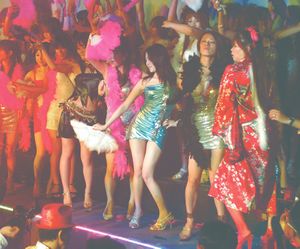Difference between revisions of "TechPara"
m (Minor proofreading, and setting up Table of Contents structures.) |
|||
| Line 1: | Line 1: | ||
__FORCETOC__ | __FORCETOC__ | ||
= TechPara = | = TechPara = | ||
| − | TechPara (テクパラ) is a variant dance of ParaPara. It is mainly danced to hyper techno and eurodance. | + | '''TechPara (テクパラ)''' is a variant dance of ParaPara. It is mainly danced to hyper techno and eurodance. |
It is important to point out that techno in the TechPara culture does not necessarily refers to techno as musical genre, instead as a short to "techno parapara" or even dance music loosely marketed as "techno". | It is important to point out that techno in the TechPara culture does not necessarily refers to techno as musical genre, instead as a short to "techno parapara" or even dance music loosely marketed as "techno". | ||
Revision as of 13:21, 7 February 2021
TechPara
TechPara (テクパラ) is a variant dance of ParaPara. It is mainly danced to hyper techno and eurodance.
It is important to point out that techno in the TechPara culture does not necessarily refers to techno as musical genre, instead as a short to "techno parapara" or even dance music loosely marketed as "techno".
TechPara sometimes incorporates genres such as j-pop and rock, and the distinction between TechPara and other dances like yogore or TraPara could be hard.
History
Juliana's Tokyo and the beginning (1991-93)
TechPara origins could be traced back to the Juliana's Tokyo opening in Japan and its popularity in the early 1990s - at that time, a lot of house and rave genres were introduced and they became known among japanese clubbers as 'Juliana's techno" (ジュリテク).
In the Juliana's era, the dancing wasn't really called TechPara and was mainly freestyle. The symbol of Juliana's was the feathered fan dancing. Fans were brought into TechPara because of Kyoto scene and it's geishas neighborhood. Maikos (young geishas) used to go to the local Maharaja carrying feathered fans, so that's how the fad started. Girls wearing bodycon (body conscious) dresses and boas danced on the otachidai, driving the male crowds crazy. The sexy dancing of Juliana's became it's trademark and media covered the boom extensively. Juliana's in the glorious days was an expensive place and it's costumers were all adults that also used to go to other discos from Tokyo, were the dress code was strict and chic. The sexy atmosphere and the media coverage also created the misguided idea that Juliana's was some sort of strip club and that's the reason of it's demise and the attendance drop.
After it's closure, some Juliana's regulars started to go to ParaPara clubs and Juliana's techno and hyper techno initiated to get played along with eurobeat sets. The end of Juliana's boom is close to the start of the second ParaPara boom, so is no surprise that both things merged at some point. Xenon, one of the biggest ParaPara clubs of that generation, did some of what could called the "first" TechPara choreographies, There is few data about that information but is meaningful that one of Xenon's ParaPara tapes is solely dedicated to TechPara, with songs like "survival dAnce" by TRF and Baila Baila by DJ Zorro. There is other Xenon videos with TechPara dances, and even some with vogue dancing, so it is also a good document to illustrate how modern TechPara started and incorporated various dance styles in its birth.
